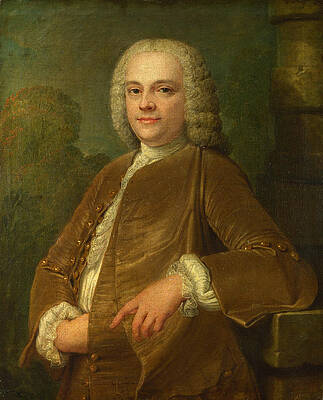Philippe Mercier
Paintings
The Sense of Sight
School for girls
A Young Woman Pulling on Her Stocking
The Sense of Taste
The Sense of Smell
The Singing Party
An Unknown Man
Portrait of a Man
Fine Art Prints | Greeting Cards | Phone Cases | Lifestyle | Face Masks | Men's , Women' Apparel | Home Decor | jigsaw puzzles | Notebooks | Tapestries | ...
Philippe Mercier (also known as Philip Mercier; Berlin, 1689 – London, 18 July 1760) was a French painter and etcher, who lived principally and was active in England. He was born in Berlin of French extraction, the son of a Huguenot tapestry-worker. He studied painting at the Akademie der Wissenschaften of Berlin and later under Antoine Pesne, who had arrived in Berlin in 1710. Later, he traveled in Italy and France before arriving in London—"recommended by the Court at Hannover"—probably in 1716. He married in London in 1719 and lived in Leicester Fields.
He was appointed principal painter and librarian to the Prince and Princess of Wales at their independent establishment in Leicester Fields, and while he was in favor he painted various portraits of the royals, and no doubt many of the nobility and gentry. Of the royal portraits, those of the Prince of Wales and of his three sisters, painted in 1728, were all engraved in mezzotint by Jean Pierre Simon, and that of the three elder children of the Prince of Wales by John Faber Junior in 1744. This last (entitled Playing Soldiers[2]) was a typical piece of Mercier's composition, the children being made the subject of a spirited, if somewhat childish, allegory in their game of play. Prince George is represented with a firelock on his shoulder, teaching a dog his drill, while his little brother and sister are equally occupied in a scene that is aptly used to point a patriotic moral embodied in some verses subjoined to the plate, of which the concluding couplet is as follows:
“ Illustrious Isle where either sex displays
Such early omens of their future praise!
”
Faber also engraved six plates of "Rural Life" after Mercier, and several other subjects of his have survived him.
Mercier became involved in a scandal of sorts and he lost favor. He left London around 1740 and settled in York, where he practiced portrait painting for over ten years, before returning to London in 1751. In 1752, Mercier went to Portugal at the request of several English merchants. He did not long remain there, however, but came back to London, where he died in 1760.
References
Academy Webpage
"Playing Soldier". Detroit Institute of Arts. 2015. Retrieved 10 September 2015.
Sources
Davies, Randall (1907). ENGLISH SOCIETY OF THE EIGHTEENTH CENTURY IN CONTEMPORARY ART. London: SEELEY AND CO. LIMITED, GREAT RUSSELL STREET/NEW YORK : E. P. DUTTON & CO. p. 37.
John Ingamells & Robert Raines, ‘A Catalogue of the Paintings, Drawings and Etchings of Philip Mercier’, Walpole Society, XLVI, 1978, pp. 1–70
Exhibition catalogue for "Philip Mercier", put on by York City Art Gallery and Kenwood in 1969
Elizabeth Einberg and Judy Egerton, The Age of Hogarth: British Painters Born 1675-1709, Tate Gallery Collections, II, London 1988
External links
Portraits by Philip Mercier at the National Portrait Gallery, London
Paintings by Philip Mercier at Tate Britain
Works by Mercier from Art.com
Works by Mercier from Invaluable.com
----
Fine Art Prints | Greeting Cards | Phone Cases | Lifestyle | Face Masks | Men's , Women' Apparel | Home Decor | jigsaw puzzles | Notebooks | Tapestries | ...
----
Artist
A - B - C - D - E - F - G - H - I - J - K - L - M -
N - O - P - Q - R - S - T - U - V - W - X - Y - Z
Retrieved from "http://en.wikipedia.org/"
All text is available under the terms of the GNU Free Documentation License













